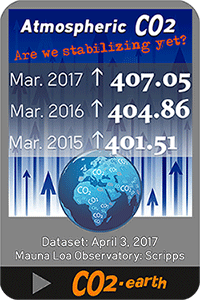 BPSDB
BPSDB
Following from Dan Pangburn: Dan commented on this, helpfully providing links to several pdfs showing where he derived his constant.
So I took a look at them.
Dan uses the First Law of Thermodynamics.
That’s a start: Energy(in) – Energy(out) = Energy(retained).
Let’s take a look at Energy(Out). A single term: X·T4, where X is Dan’s constant.
Dan helpfully provides a link to Wikipedia’s A very simple model. This shows
(1-a)S = 4εσT4
where
- S is the solar constant – the incoming solar radiation per unit area—about 1367 W·m−2
- a is the Earth’s average albedo, measured to be 0.3
- σ is the Stefan-Boltzmann constant—approximately 5.67×10−8 J·K−4·m−2·s−1
- ε is the effective emissivity of earth, about 0.612
Dividing both sides by (1-a)S, we get 1 = Y·T4 where Y = 4εσ/(1-a)S.
Plugging in the terms into Y, we get
Y = (4 x 0.612 x 5.67×10−8)/(0.7 x 1367) K−4
= 1.45·10-10 K−4
(or 1·10-10 K−4 to 1 s.f. – we can’t justify more than one significant figure)
Y can’t really be a constant, though, since 1 = Y·T4. If T increases then Y must decrease (and vice versa). Perhaps we should rewrite it as Yi·Ti4 = 1. But for small ΔT Y will not change by much.
So far, so good.
Dan derives his constant in the same way, but then multiplies an additional term (the average sunspot count).
Quoting from his pdf on page 6:
The average sunspot number since 1700 is about 50, the energy radiated from the planet is about 342*0.7 = 239.4 (for the units used) and the earth’s effective emissivity is about 0.61 (http://en.wikipedia.org/wiki/Global_climate_model). Thus, as a place to start, X should be about 50/239.4 times the Stephan-Boltzmann constant times 0.61.
50/239.4*5.67E-8 *0.61 = 7.2E-9
Which then he “refines”, continuing:
With this plugged into the equation, a plausible graph is produced with a dramatic change observed to take place in about 1940. In EXCEL, 7.2E-9 was placed in a cell and the cell (value for X) called by the equation which produced a graph. The graph was observed as the value for X was varied. X was adjusted until the net energy from 1700 to about 1940 exhibited a fairly level trend. This occurs when X is 6.519E-9 (unbeknownst to me at the time, cell formatting rounded it to 6.52E-9).If an average sunspot number of 6.52/7.2*50 = 45.28 had been used, no adjustment would have been needed.
This is, of course, nonsense.
But we will follow this for now to see where it goes.
If we now multiply Y by Dan’s sunspot average count, we get
45.28Y = 45.28 x 1.45·10-10 K−4
= 6.56·10-9 K−4.
This is pretty close to Dan’s value (the difference is probably due to slightly different values of the terms S & ε, which I had used from the model).
To all intents and purposes X = 45.28Y.
Now go back to Dan’s term X·T4, the output energy.
Replacing X with 45.28Y, and remembering that Y·T4 = 1 (so that Y = T-4), we get
X·T4 = 45.28·T-4·T4.
Gosh! The Temperature terms cancel, the Stefan-Boltzmann equation vanishes, and the energy we are left with is ….
45.28 Sunspots ….
Solar & Heliospheric Observatory
We give our consent every moment that we do not resist.
Comment Policy
–
It is worth knowing and abiding by whether you comment on this blog or not.
- The “Mostly” Open Thread” is for general climate discussion that is not relevant to a particular post. Spam and abuse rules still apply;
- The “Challenging the Core Science” Comment Thread is for comments that purport to challenge the core science of anthropogenic climate change.
- The “Spam” Comment Thread is for comments posted by people who think that they can ignore site policy.
:












